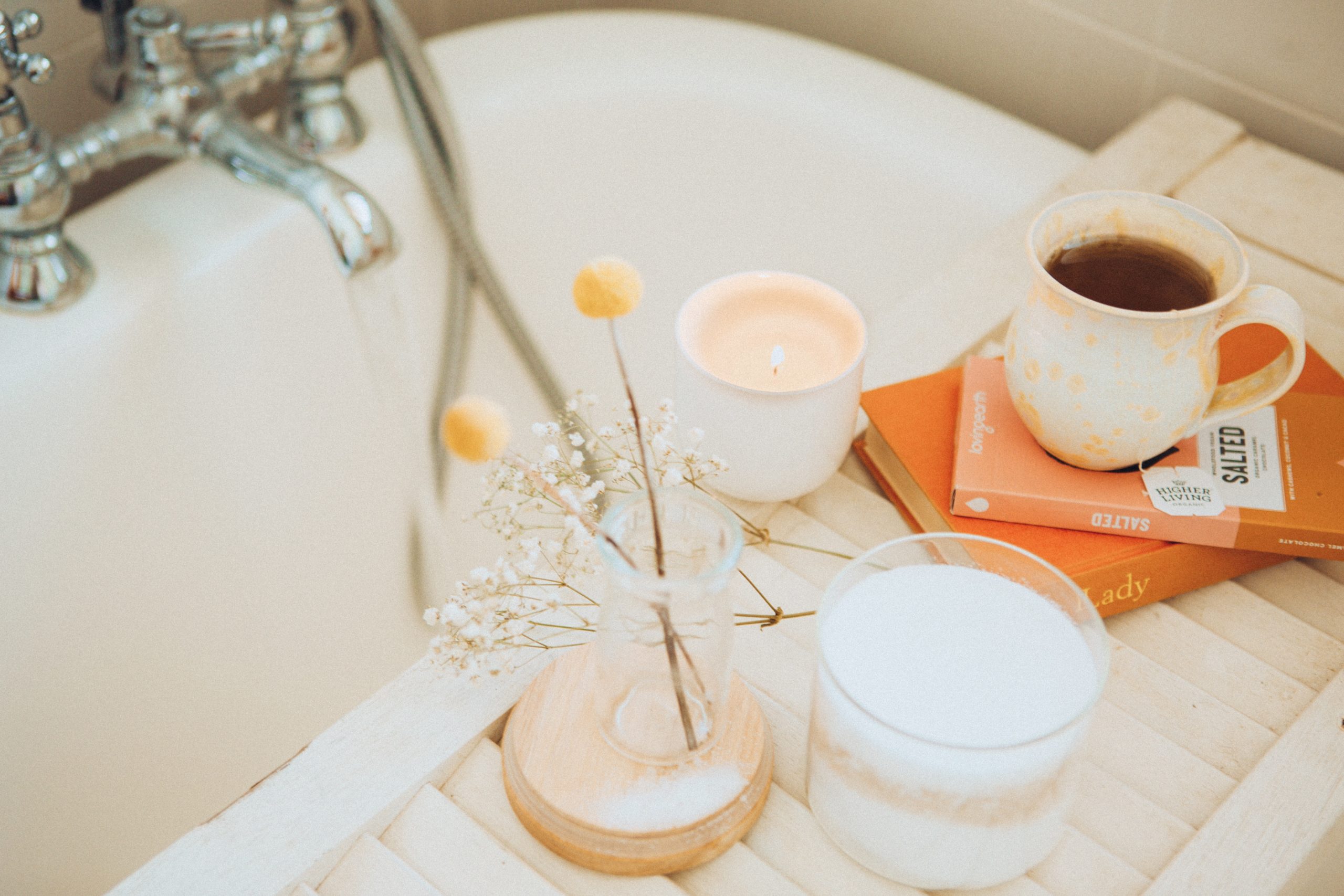
A Working Mom’s Guide to Self Care and Healthy Boundaries
By the end of this guide, you will:
Understand how to avoid burnout and set yourself up to thrive by setting strong boundaries that help you maintain a consistent self care routine.
You will need:
- A notebook
- A pen or pencil
- A moment to yourself
Why You’re Here
There’s only one way to put it, mama—you’re tired. You’re exploring this guide hoping to glean a nugget of wisdom that brings more balance to your life. There’s never enough time in your day to take care of yourself because you prioritize the people you love and the career you’ve worked so hard to build. The problem? You’re at risk of burning out. Maybe you already have.
But if you set aside time to read, think, and journal with me in this guide, that’s all about to change.
The Danger of Caregiver Burnout
We’re raised with unrealistic images of what it means to be a professional and a mother. From idealized portrayals of “perfect” mothers on television and social media to the pressures we face at work, we’re often expected to do too much for too many people.
These unrealistic expectations can lead us to neglect our own needs, and if we do that long enough, it eventually leads to burnout.
Deep down, many working moms feel like they’re on the verge of burnout. But for some reason, we tend to keep these feelings to ourselves. The truth is that mom burnout is an epidemic and has a name—caregiver burnout.
What is caregiver burnout?
Caregiver burnout is a term used by mental health professionals to describe a state of physical, emotional, and mental exhaustion when caring for someone else. Eventually, it leads to a decreased quality of life and puts your mental and physical health at risk.
And as mamas, we spend a lot of time caring for others. Throw ailing parents, a dysfunctional partner, or a highly demanding career into the mix, and your stress levels can quickly reach a boiling point.
Is caregiver burnout the same as stress?
Caregiver burnout is different from stress. Stress is a normal response to the demands of life. It’s a manageable feeling that goes away once the demands of a situation have passed.
For example, you might feel stressed if you’re running late to pick up your kids from school while also trying to get dinner on the table and help with homework. But once dinner is served and homework is finished, the feeling should resolve itself.
On the other hand, caregiver burnout is a more chronic state of exhaustion that can last for weeks, months, or even years. And if left unchecked, it can seriously affect your mental and physical health.
Who is at risk for caregiver burnout?
Caregiver burnout is often caused by the stress of caring for someone 24/7, with little to no help or time to yourself. And while it can happen to anyone who takes on the role of caregiver, it’s widespread among working mothers.
While it may seem obvious that single, low-income mamas are at risk for caregiver burnout, you may be surprised to learn that partnered and well-compensated mamas are at risk, too.
Burnout shows no mercy when it comes to being rich or poor, single or coupled. The reality is that any working woman with the burden of caring physically and emotionally for one or more people in her household is at risk of burning herself out.
How do you know when you’re suffering from burnout?
There are a few key signs to look out for that may indicate you’re suffering from burnout and need to revamp your self-care routine.
- You’re having more blowups than usual.
- Your life is chaotic (home is messy, more forgetful than usual, can’t stick to a set routine).
- You aren’t spending much time with friends or family (outside of children).
- Your health is no longer a priority.
- Breaking boundaries you used to set for yourself around self-care.
- You’re feeling anxious, isolated, and depressed.
- You’re relying on unhealthy coping mechanisms (alcohol, drugs, overeating).
Any of these sound familiar? If you’re nodding your head in agreement, it’s time to hit the reset button and make a plan to invite more balance into your life.
How do you avoid burnout?
Setting healthy boundaries that allow you the time and space you need for self-care is the best way to avoid burnout. This guide will help you identify areas of your life that feel chaotic so you can give yourself the gift of balance.
Activity 1: Reflecting on Burnout
Get your journal and pen ready, mama; we’re about to get real with some journaling.
Journaling is an invitation to reflect, manifest, and set your intentions. It’s how we’re going to uncover the areas where you’ve started to let yourself go so you can begin to invite more balance into your life.
In your notebook, take a few minutes to answer these questions.
You can make a list, doodle an image, jot down a stream of consciousness, or write an entire page if you wish.
- What does burnout look like for you? How do you know when it’s time to hit the reset button?
- What self-care boundary did you used to have that you’ve recently broken?
- Imagine you have your time and energy gifted back to you. How would you use it?
Identify Areas of Balance and Chaos
Have you ever had those days when it feels impossible to finish everything on your to-do list? I bet you’ve had a lot of them, mama. These are the days when we start to settle for less. And the more of them we have, the more we become used to ignoring our needs and boundaries.
That yoga class you signed up for? It can be rescheduled.
The book you’ve been meaning to write? Someday, once things have settled down.
Sleep? You wish!
When we feel overwhelmed by the weight of caregiving tasks on top of professional obligations, it creates chaos in our lives. In response, we tend to sacrifice our wellbeing to accommodate the chaos rather than resist it by holding firm to our boundaries.
You can minimize the chaos by doing the opposite—creating routines and holding firm to boundaries that actively combat problem areas. Doing so will give you more time for self-care and things that bring you joy.
So how do you know where you need more boundaries and routines in your life? We can begin by separating life into five focus areas. From there, we can zoom in on the pillars of each focus area to determine where we need to find more balance.
Physical Wellbeing
Physical wellbeing is complex. But for the sake of our guide, we’re going to break it down into these three areas:
Diet
Are you nourishing your body with healthy foods? Are you staying away from foods that irritate your allergies or make you feel inflamed? Diet can also include vices like alcohol, drugs, or smoking. How thoughtful are you about what you feed your one and only body?
Exercise
Exercising isn’t just about how you look afterward. Exercise can transform your mental and emotional wellbeing, too. You don’t have to punish yourself with 10-mile runs or brutal HIIT sessions to say you worked out. Walking, yoga, and light jogging can be better in many situations. Are you finding ways to move your body each day?
Sleep
Be honest, mama. Are you getting your eight hours? Are you holding true to your bedtime? Or are you self-sabotaging by robbing yourself of quality shut-eye?
Mental Wellbeing
Your mental wellbeing is another complicated aspect of self-care, but we can simplify it based on some key concepts. To maintain a sound mental state, it’s essential to focus on the following:
Contentment
Contentment is the opposite of anxiety. How at ease do you feel in your life? Are you constantly on edge, suffering from racing thoughts? You don’t have to feel anxious every day, lady.
Joy
Are you finding joy in your days and weeks? Or do you feel hopeless, isolated, and depressed? Depression is a prevalent ailment, especially for burnt-out mamas who feel like they can’t ever take a moment for themselves.
Stability
Consider your mood from day to day. Is it relatively stable, or are you experiencing intense mood swings that you can’t explain? If so, you could be experiencing burnout.
Emotional Wellbeing
While it’s important to remember that you are ultimately in control of your emotions, it’s helpful to reflect on how we feel when we’re alone and with others. Consider these three pillars of emotional wellbeing:
Friendships & Partnerships
Finding quality time to spend with uplifting friends and people you love is crucial to your emotional wellbeing. How do the people around you make you feel? Are you leaning into your relationships, or are you pulling away?
Parenting & Caregiving
Parenting styles and our children’s struggles can have a tremendous impact on our emotions. The disappointment of losing a big game, fights about chores and curfews, all of it can throw us off emotionally.
Self-Perception
Let’s check in on your self-talk. Are you proud of the woman you see when you look in the mirror? Do you tell her she’s beautiful and she’s out there doing her best, or do you put her down and compare her to others?
Spiritual Wellbeing
Whether you are or aren’t affiliated with a particular faith, we all need to be spiritually nourished in some way. Here are some spiritual pillars to consider:
Spiritual Fulfillment
Are you living a life that feels true to you? Do you have a unique set of values and beliefs that guide your actions, or do you feel like you’re just going through the motions day after day?
Personal Ritual
If you follow a specific faith, are you upholding the rituals that bring you spiritual joy? If you don’t follow a particular religion, are you setting aside time for things that are healing to your soul, such as meditation or journaling?
Professional Wellbeing
You’re a working mama and deserve to be fully happy in your professional pursuits. Here are some professional pillars to think about:
Work/Life Balance
How’s your work/life balance? Are you spending too much time at the office and not enough time with your family? Are you taking advantage of your company’s flexible work policy?
Professional Fulfillment
Your career shouldn’t feel like a dead end. Do you feel you add value to the world through your craft, or do you dream of spending your time in a different role?
Dream Chasing
You’ve got to make time to chase those dreams. Are you in the right field, or do you feel like you’re stuck in a job that doesn’t make use of your talents and skills? Do you make time for innovation and growth towards your big goals? Do you make time to create, travel, invent or anything else that brings you joy?
How do you find balance in all of these areas?
Phew, that was a lot! But you’re a complex creature, mama. And yes, it is possible to practice self-care in all the ways you deserve. And it starts with identifying which of these areas need more balance.
Activity 2: The Chaos Scale
Make sure your journal is handy!
Now that we’ve zoomed in on some of the major pillars of our wellbeing, it’s time to root out the areas that need to be rebalanced.
If an area of your life feels unbalanced, it invites chaos. It’s the chaos that throws us off and makes us forget all about self-care and healthy boundaries.
For this activity, you will rate the level of control or chaos you feel within the following pillars of wellbeing using The Chaos Scale.
A zero on the Chaos Scale means you feel 100% in control and are fully satisfied with your wellbeing in that area. A ten means you feel wildly out of control of that area—something that consumes your time and brings you intense feelings of anxiety.
Rate the following categories and pillars on the chaos scale of 1-10.
Physical Wellbeing
- Diet
- Exercise
- Sleep
Mental Wellbeing
- Contentment
- Joy
- Stability
Emotional Wellbeing
- Friendships & Relationships
- Parenting & Caregiving
- Self-Perception
Spiritual Wellbeing
- Spiritual Fulfillment
- Personal Ritual
Professional Wellbeing
- Work/Life Balance
- Professional Fulfillment
- Dream Chasing
So, which area(s) of your life feel the most stressful? Keep these problem areas in mind as we head into the final section of this guide.
Set Boundaries To Invite Joy and Peace
How often have you found yourself saying yes to something because you didn’t want to hurt someone’s feelings or disappoint them? Or maybe you skipped something important to you so you could do something for someone else. If you frequently find yourself in either of these situations, it might be time to set some boundaries.
By setting boundaries, you can control your life and schedule. You can make time for self-care and maintain a consistent routine in all the big five areas of your life.
When you say no to someone, you also say yes to yourself. Saying no means you are taking care of yourself. When you don’t take time for yourself, you won’t be able to give anything else.
Healthy Boundaries
So what do healthy boundaries in your personal and professional life look like?
In your personal life, you might set boundaries around how much time you spend with family or friends. You might also set boundaries in your relationships with romantic partners, children, or roommates. You might even set personal boundaries regarding how you allow yourself to spend time.
In your professional life, you might set boundaries around the number of hours you work or how much work you bring home. You might also set boundaries with clients or customers.
Some other examples of setting personal boundaries are:
- Asking for help when you need it
- Saying no to requests that you can’t or don’t want to do
- Setting limits on how much time you spend on your phone, social media, or watching TV
- Telling people when they’ve crossed a line
- Having alone time every day
- Doing something for yourself every day
Some examples of setting professional boundaries are:
- Not checking work email outside of work hours
- Keeping work and personal life separate
- Delegating tasks to others
- Saying no to projects that are not a good fit
- Asking for help from colleagues
- Setting limits on how much overtime you will work
Remember, you don’t have to do everything yourself, and you don’t have to always please everyone. However, setting boundaries will help increase the time you have left to spend on crucial self-care activities.
Activity 3: Practice Holding Firm Boundaries
Okay, you know what healthy boundaries are. But when it comes down to it, how exactly do you communicate them to others? And how do you stay firm when things start to get tough?
Let’s practice!
The following sentences pose a situation that might test your boundary-holding abilities. For each one, think about what you would say or do to maintain your boundary in that situation.
- You’ve been pretty exhausted the last few days after work, and you’d like to relax instead of worrying about making dinner.
- You’re feeling stressed by the amount of work your boss has been giving you. Suddenly, they ask you to take on an urgent new project.
- You planned on wrapping up dinner and homework before 7 pm so you could relax and practice some self-care routines. However, your child is procrastinating in getting started with their homework and asked if they could just do it later.
- You set aside time to focus on creative writing and closed the door to focus, but your child knocks on the door and starts asking you questions.
- Your boss is pressuring you to stay late at work to finish a project, but you have already made plans.
Here are some example answers:
- “I’d appreciate it if you made dinner or just ordered something—I need a break.”
- “Actually, I’m not comfortable taking on a new project.”
- “Your homework needs to be done now, not later.”
- “Please don’t interrupt me when my door is closed.”
- “Work-life balance is a priority for me, so I need to leave on time today.”
Now that you know how to ask for the time you need to hold your boundaries firm let’s make a plan for focusing on your self-care practice.
Activity 4: Committing To Self-Care
Earlier, you identified the areas of your life that feel chaotic and need balance. Now, you’ll make a plan for how you will take care of yourself in those areas.
Self-care is the practice of taking care of yourself physically and emotionally. This can include things like getting enough sleep, eating healthy foods, exercising regularly, and spending time with loved ones. It also includes taking time for yourself, doing things that make you happy, and learning how to deal with stress healthily.
Think about each of your big five areas of self-care. Then, write down one thing you can do to improve how you care for yourself in that area. Then, make a commitment to yourself to do that thing for the next week.
For example:
- Physical Wellbeing: I will commit to getting at least 30 minutes of exercise three times this week.
- Mental Wellbeing: I will journal about my mood and feeling for 15 minutes every day this week.
- Emotional Wellbeing: I will spend 30 minutes doing something I enjoy every day this week.
- Spiritual Wellbeing: I will meditate for 10 minutes every morning.
- Professional Wellbeing: I will leave on time every day this week.
Alright, your turn! Take a few minutes to write down your commitments to yourself in your journal, and stop at nothing to make sure you stay true to them.
Now that you’ve read this article, are you feeling more confident about implementing a solid self-care plan and avoiding burnout by sticking to your boundaries? I believe in you, mama—you can do anything you set your mind to.
Final Thoughts
If you dream of pursuing your passions but aren’t sure what steps to take, the Busy Women, Big Dreams Beginner Membership was made for you. In addition to receiving your very own copy of our best-selling guide, The Playbook: Guide to Following Your Dreams, your membership includes a curated toolkit of resources to help you launch into action.
Created by a successful woman business owner (who happens to also be a busy mom!), this beginner-level membership offers you a chance to build your business on your own terms. Designed especially with the needs of busy women in mind, The Busy Women, Big Dreams Beginner Membership will launch you into action while you learn to invest in yourself and your dreams FIRST.
Learn more about the benefits of a membership today.





Comment